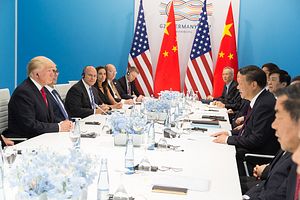Trans-Pacific View author Mercy Kuo regularly engages subject-matter experts, policy practitioners and strategic thinkers across the globe for their diverse insights into the U.S. Asia policy. This conversation with Daniel Russel – Diplomat in Residence and Senior Fellow at the Asia Society Policy Institute and career member of the Senior Foreign Service at the U.S. Department of State, who most recently served as the Assistant Secretary of State for East Asian and Pacific Affairs and formerly served at the White House as Special Assistant to the President and National Security Council (NSC) Senior Director for Asian Affairs, where he helped formulate President Obama’s strategic rebalance to the Asia Pacific region – is the 108th in “The Trans-Pacific View Insight Series.”
What were the key accomplishments of the U.S. rebalance to Asia?
First, the rebalance strengthened and modernized U.S. relations with regional allies and security partners. This not only enhanced security collaboration, it also improved cooperation in other areas such as combating climate change, pandemic diseases, and cybercrime.
The rebalance helped lay the foundation for a steadier and more productive U.S.-China relationship by promoting cooperation on areas of shared interests while enabling us to manage, and in some cases resolve, differences.
The successful negotiation of the Trans-Pacific Partnership (TPP) established access to Asian markets by greatly reducing tariff barriers. At the same time, TPP put forth high labor and environmental standards, strengthened intellectual property safeguards, cracked down on wildlife trafficking, and promoted a free and open internet.
Finally, the rebalance strengthened people-to-people ties, particularly, engagement with youth throughout Asia. A great example is the Young Southeast Asian Leaders Initiative (YSEALI) program. Since 2013, YSEALI has helped to develop the leadership capabilities of Southeast Asian youth and improve ties between the United States and Southeast Asia, including through educational and cultural exchanges that bring promising young leaders to America for educational and professional development programs. Along these same lines, other bilateral programs such as the Work, English, Study, Travel (WEST) program with South Korea, have given Asian students a chance to come to the U.S. for educational training, to build cross-cultural relationships and to gain exposure to American culture.
How would you describe U.S. post-rebalance strategic direction in Asia?
When I meet with Asia friends and counterparts, I am often asked about mixed messages coming from Washington on trade, commitments to treaty alliances, and our willingness to contribute to multinational efforts to combat global threats such as climate change. On issues such as non-proliferation, maritime security, and trade, some worry that the U.S. could abandon long-held principles or support for multilateral institutions and regional diplomacy. Many of our partners are troubled by the slow pace of appointments to key positions at the State Department and other U.S. agencies, which they say hampers their ability to engage with the U.S. government.
However, it is important to recognize that while the occupant of the White House may change, U.S. national interests do not. That helps explain why there are many important areas of continuity in U.S. Asia policy. These include continuing efforts to deal with North Korea through a combination of deterrence, pressure and dialogue, sustaining deep engagement with allies such as Japan, Australia and South Korea, and active participation in multilateral regional meetings built around ASEAN, such as the East Asia Summit that President Trump is expected to attend in November.
Amid uncertainty over U.S. leadership in Asia, how is China reshaping the region’s economic and security landscape?
Chinese economic projects such as the Belt and Road Initiative (BRI) are enticing to many countries in and beyond the region, particularly those seeking financing to build-up underdeveloped transportation and infrastructure networks. After the U.S. withdrawal from TPP, some Asian countries ask if China, already their primary trading partner, is destined to become “the only game in town.” Nevertheless, China’s role in the region is not universally perceived as benign. In addition, most Asian countries continue to seek sustained, robust U.S. economic engagement. Most value America’s role as an investor, an innovator, and a stabilizing presence in the region. Nearly all also value continuation of America’s longstanding role as the region’s guarantor of security, champion of international law, and responder of first resort in crises and natural disasters.
The last thing countries in the region want is to be forced to choose between China and the U.S. Rather, they want to be able to make their own choices and to be secure against coercion or encroachment on their sovereignty.
Assess Japan’s strategy in counterbalancing China’s growing regional influence.
Japan is a staunch champion of the rule of law and a model for strong democratic traditions and institutions. My perception is that like the United States and other Asia Pacific countries, Japan wants good relations with China and benefits from Chinese economic growth. Japan, like the U.S., also has an abiding interest in China’s internal social stability and therefore has concerns about rising nationalism and diminishing domestic political space.
Japan exerts influence in the region by opening its markets, protecting human and civil rights, contributing to regional security, pursuing generous development programs, and practicing an active values-based diplomacy in both bilateral relations and multilateral forums. The Japanese government has been resolute in opposing coercion, unilateral action to alter regional norms, and threats to the rule of law by any country.
Identify three areas of cooperation for the U.S. and regional allies to advance shared interests.
First, the U.S. and its allies must intensify cooperation, along with China and Russia, to address the threat posed by North Korea’s nuclear program, which is in flagrant defiance of international law.
Second, the U.S. and its partners can and should do more to promote pluralism and tolerance, particularly in Southeast Asia, while intensifying the fight against violent extremist ideologies propagated by ISIL.
Third, we can all search for ways to make a more open, transparent, and fair environment for trade in the Asia-Pacific with a particular emphasis on upgrading environmental, labor, legal, and human rights standards.

































